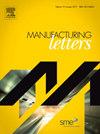Analytical temperature model for spindle speed selection in additive friction stir deposition
IF 1.9
Q3 ENGINEERING, MANUFACTURING
引用次数: 0
Abstract
This paper describes a physics-based, analytical model for additive friction stir deposition (AFSD) spindle speed selection to achieve a desired deposition temperature. In the model, power input to the feedstock, which enables plastic flow and deposition, is related to the material temperature rise and subsequent flow stress reduction using Fourier’s conduction rate equation. Power input is modeled as frictional heating at the deposit-surface interface and adiabatic heating due to plastic deformation. The flow stress is predicted using the strain, strain rate, and temperature-dependent Johnson-Cook constitutive model for the selected feedstock alloy. Model predictions are compared to AFSD numerical simulation results available in the literature and experiments for aluminum alloys.
用于在添加剂摩擦搅拌沉积过程中选择主轴转速的温度分析模型
本文介绍了一种基于物理学的分析模型,用于选择添加剂摩擦搅拌沉积(AFSD)主轴转速,以达到所需的沉积温度。在该模型中,对原料的功率输入(可实现塑性流动和沉积)与材料温升和随后的流动应力降低有关,采用的是傅里叶传导率方程。输入功率被模拟为沉积物表面界面的摩擦加热和塑性变形引起的绝热加热。流动应力是使用应变、应变率和温度相关的约翰逊-库克构成模型对所选原料合金进行预测的。模型预测结果与铝合金的 AFSD 数值模拟结果和实验结果进行了比较。
本文章由计算机程序翻译,如有差异,请以英文原文为准。
求助全文
约1分钟内获得全文
求助全文
来源期刊

Manufacturing Letters
Engineering-Industrial and Manufacturing Engineering
CiteScore
4.20
自引率
5.10%
发文量
192
审稿时长
60 days
 求助内容:
求助内容: 应助结果提醒方式:
应助结果提醒方式:


